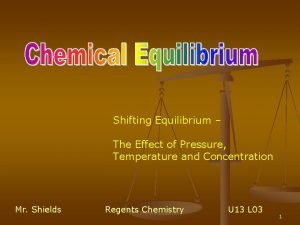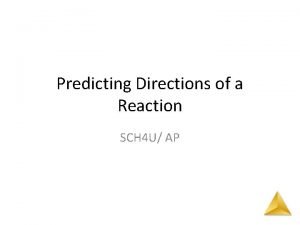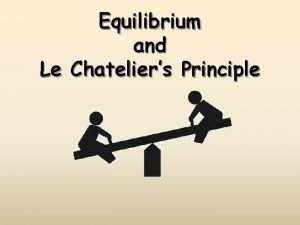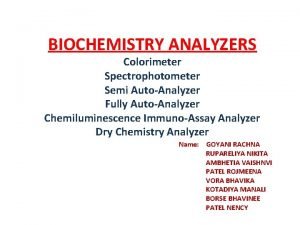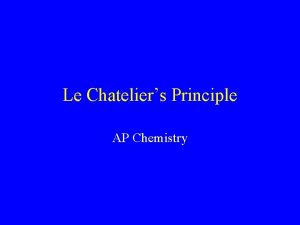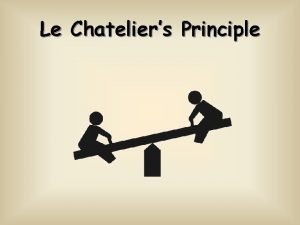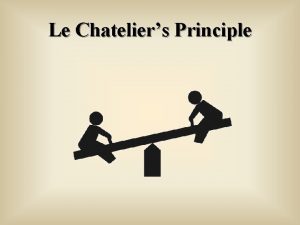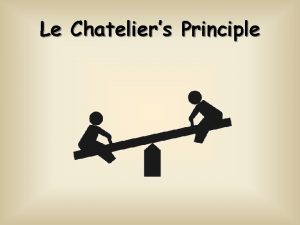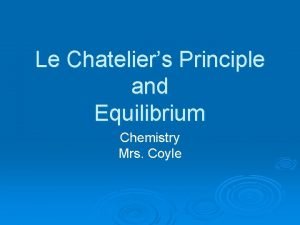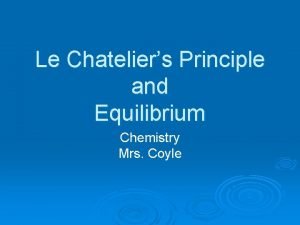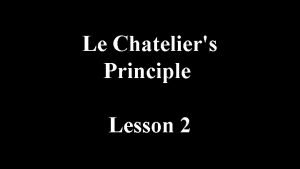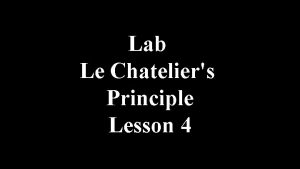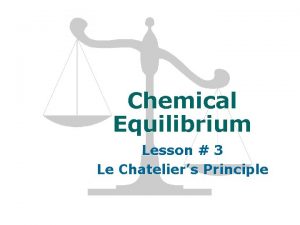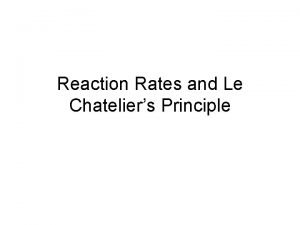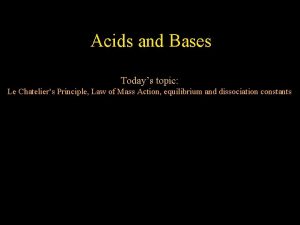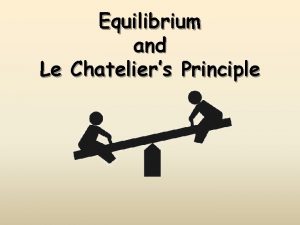Lesson 5 4 Le Chateliers Principle Chemistry 2















- Slides: 15

Lesson 5. 4 Le. Chatelier’s Principle Chemistry 2 Honors Northwestern High School Dr. J. Venables

Effects of Volume and Pressure Changes • As volume is decreased pressure increases. • Le Châtelier’s Principle: if pressure is increased the system will shift to counteract the increase. • That is, the system shifts to remove gases and decrease pressure. • An increase in pressure favors the direction that has fewer moles of gas. • In a reaction with the same number of product and reactant moles of gas, pressure has no effect.

Effects of Volume and Pressure Changes • An increase in pressure (by decreasing the volume) favors the formation of colorless N 2 O 4. • The instant the pressure increases, the system is not at equilibrium and the concentration of both gases has increased. • The system moves to reduce the number moles of gas (i. e. the reverse reaction is favored). • A new equilibrium is established in which the mixture is lighter because colorless N 2 O 4 is favored.

• Increasing total pressure by adding an inert gas has no effect on the partial pressures of reactants and products, therefore it has no effect on the equilibrium. Effect of Temperature Changes • The equilibrium constant is temperature dependent. • For an endothermic reaction, H > 0 and heat can be considered as a reactant. • For an exothermic reaction, H < 0 and heat can be considered as a product.

• Adding heat (i. e. heating the vessel) favors away from the increase: – if H > 0, adding heat favors the forward reaction, – if H < 0, adding heat favors the reverse reaction. • Removing heat (i. e. cooling the vessel), favors towards the decrease: – if H > 0, cooling favors the reverse reaction, – if H < 0, cooling favors the forward reaction.

• Consider for which H > 0. – Co(H 2 O)62+ is pale pink and Co. Cl 42 - is blue. – If a light purple room temperature equilibrium mixture is placed in a beaker of warm water, the mixture turns deep blue. – Since H > 0 (endothermic), adding heat favors the forward reaction, i. e. the formation of blue Co. Cl 42 -.

• Consider – If the room temperature equilibrium mixture is placed in a beaker of ice water, the mixture turns bright pink. – Since H > 0, removing heat favors the reverse reaction which is the formation of pink Co(H 2 O)62+.


Le Châtelier’s Principle The Effect of Catalysis • A catalyst lowers the activation energy barrier for the reaction. • Therefore, a catalyst will decrease the time taken to reach equilibrium. • A catalyst does not effect the composition of the equilibrium mixture.


SO 3 (g) SO 2 (g) + 1/2 O 2 (g) • ΔH = +98. 9 k. J • Determine the effect of each of the following on the equilibrium (direction of shift) – What happens to the concentration of SO 3 after each of the changes? A) Addition of pure oxygen gas. B) Compression at Constant Temperature C) Addition of Argon gas D) Decrease temperature E) Remove sulfur dioxide gas F) Addition of a catalyst

• • • Calculating Equilibrium Concentrations The same steps used to calculate equilibrium constants are used. K is given. Generally, we do not have a number for the change in concentration line. Therefore, we need to assume that x mol/L of a species is produced (or used). The equilibrium concentrations are given as algebraic expressions. We solve for x, and plug it into the equilibrium concentration expressions.

Example – 2 NO 2 (g) N 2 O 4 (g) Kc = 0. 75 If the initial concentration of NO 2 is 0. 50 M and the initial concentration of N 2 O 4 is 0. 90 M, what will the equilibrium concentrations be? If the initial concentration of N 2 O 4 is 1. 00 M (no NO 2 present), what will the equilibrium concentrations be?

Example – H 2 (g) + Fe. O (s) H 2 O (g) + Fe (s) Kc = 5. 20 If the initial concentration of H 2 is 0. 50 M and the inintial concentration of H 2 O is 6. 50 M, what will the equilibrium concentrations be? If the initial concentration of H 2 is 1. 00 M (no H 2 O present), what will the equilibrium concentrations be?

N 2 (g) + 3 H 2 (g) 2 NH 3 (g) ΔH < 0 How can we maximize the amount of ammonia produced in the Haber process, shown above?
 Le chatelier's principle heat
Le chatelier's principle heat Le chateliers principle
Le chateliers principle Le chatelier's principle class 11
Le chatelier's principle class 11 Ib organic chemistry
Ib organic chemistry Inorganic vs organic chemistry
Inorganic vs organic chemistry Semi biochemistry analyzer
Semi biochemistry analyzer Unit 9 lesson 4
Unit 9 lesson 4 Lesson outline lesson 3 describing circuits answers
Lesson outline lesson 3 describing circuits answers Kind of fault
Kind of fault Lesson outline lesson 2 aquatic ecosystems answer key
Lesson outline lesson 2 aquatic ecosystems answer key Micro planning in education
Micro planning in education L 101 lesson 2
L 101 lesson 2 Gift of chappals images
Gift of chappals images Chapter 1 lesson 1 your total health lesson 1 quiz answers
Chapter 1 lesson 1 your total health lesson 1 quiz answers Lesson outline lesson 3 answer key
Lesson outline lesson 3 answer key Sat vocabulary lesson and practice lesson 4
Sat vocabulary lesson and practice lesson 4
